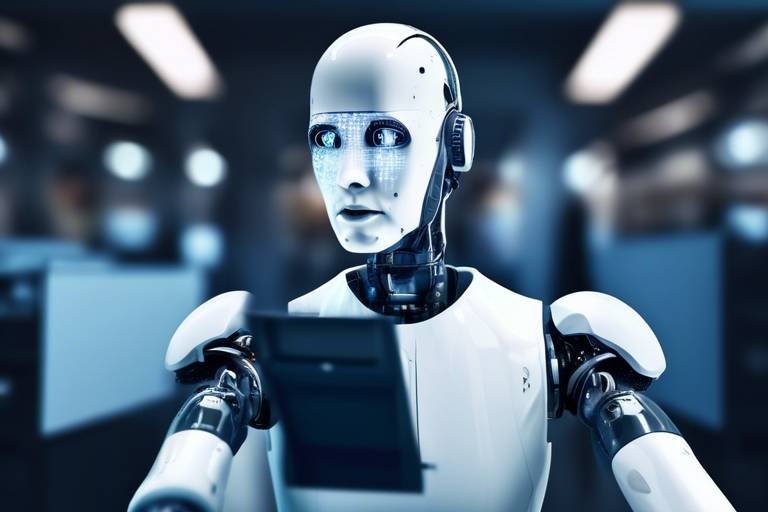AI-Driven Software Testing: The Future of Software Development
In the ever-evolving world of technology, AI-driven software testing is emerging as a game-changer in the software development landscape. Imagine a world where testing processes are not only faster but also more accurate, allowing developers to focus on innovation rather than getting bogged down by mundane tasks. This is not just a dream; it’s becoming a reality thanks to the integration of artificial intelligence in testing methodologies. By automating repetitive tasks and enhancing the precision of testing, AI is paving the way for a more efficient, reliable, and agile software development process. So, let’s dive deeper into how AI is transforming software testing and what it means for the future of development.
AI is revolutionizing the way we approach software testing. Traditionally, testing has been a labor-intensive process, often riddled with human error and inefficiencies. However, with the advent of AI tools, organizations can now automate a significant portion of the testing process. These tools are designed to integrate seamlessly into existing workflows, providing support in various testing phases, from planning to execution and reporting. For instance, AI can analyze large volumes of data quickly, identify patterns, and even predict potential issues before they arise. This not only saves time but also enhances the overall quality of the software being developed.
The incorporation of AI in testing strategies brings a plethora of advantages that can significantly enhance the software development lifecycle. One of the most notable benefits is the improved efficiency it offers. By automating routine tasks, teams can execute tests more rapidly and with greater precision. This leads to faster release cycles and a more agile response to market demands. Additionally, AI-driven testing can lead to substantial cost reductions by minimizing the need for extensive manual testing and allowing teams to allocate resources more effectively. Moreover, AI enhances test coverage by identifying edge cases and potential bugs that human testers might overlook, ensuring a more comprehensive assessment of the software.
AI tools streamline the testing process, allowing teams to execute tests faster and more effectively. This is particularly important in today’s fast-paced development environments, where time-to-market can make or break a product. By leveraging AI, organizations can conduct regression tests, performance tests, and even security assessments in a fraction of the time it would take using traditional methods. The result? A more responsive development team that can adapt quickly to changes and deliver high-quality software consistently.
One of the most significant impacts of AI on software testing is its ability to automate mundane tasks. Think of it as having a highly efficient assistant that takes care of the boring stuff, allowing testers to concentrate on complex problems that require human intuition and creativity. This shift not only boosts productivity but also enhances the quality of the software being tested. With AI handling repetitive tasks like test case execution and data validation, teams can focus on exploratory testing and other critical areas that drive innovation.
AI enables comprehensive test coverage by identifying edge cases and potential bugs that manual testing might overlook. In software development, missing even a small bug can lead to significant issues down the line, affecting user experience and company reputation. AI tools can analyze vast amounts of data and simulate numerous scenarios to ensure that every potential issue is addressed. This thoroughness is crucial in maintaining high standards of software quality and reliability.
Despite its numerous benefits, implementing AI in software testing is not without challenges. Organizations often face integration issues, as existing systems may not be compatible with new AI tools. Additionally, there is a growing need for skilled personnel who can effectively leverage these technologies. Companies must invest in training and development to ensure their teams are equipped to harness the full potential of AI in their testing processes.
The future of AI-driven software testing is bright and filled with exciting possibilities. As technology continues to advance, we can expect to see emerging trends like predictive analytics and machine learning playing a pivotal role in shaping testing methodologies. Organizations that embrace these trends will not only enhance their testing strategies but also gain a competitive edge in the market.
Predictive analytics can forecast potential defects and improve test planning. By analyzing historical data and identifying patterns, AI can provide valuable insights that help organizations prioritize testing efforts. This proactive approach not only saves time but also ensures that critical issues are addressed before they escalate into bigger problems.
Machine learning algorithms continuously learn from testing data, optimizing testing processes over time. This means that the more these algorithms are used, the better they become at identifying issues and suggesting improvements. As a result, organizations can expect a continual enhancement in their testing practices, leading to higher quality software and improved user satisfaction.
- What is AI-driven software testing? AI-driven software testing refers to the use of artificial intelligence technologies to automate and enhance the software testing process.
- What are the main benefits of AI in software testing? The main benefits include increased efficiency, cost reduction, enhanced test coverage, and improved accuracy in identifying bugs.
- What challenges do organizations face when implementing AI testing? Common challenges include integration issues with existing systems and the need for skilled personnel to manage and utilize AI tools effectively.
- What future trends can we expect in AI testing? Future trends include the use of predictive analytics for better test planning and the continuous optimization of testing processes through machine learning algorithms.

The Role of AI in Software Testing
Artificial Intelligence (AI) is not just a buzzword; it's a game-changer in the realm of software testing. By integrating AI into the testing process, organizations are witnessing a significant shift in how they approach quality assurance. Imagine having a tireless assistant that can analyze vast amounts of data, identify patterns, and execute tests faster than any human could. That’s exactly what AI brings to the table!
One of the key roles of AI in software testing is its ability to automate repetitive tasks. Traditional testing methods often involve a lot of manual work, which can be tedious and prone to human error. With AI, these mundane tasks can be handled swiftly and accurately, allowing human testers to focus on more complex and creative aspects of testing. This not only enhances productivity but also improves the overall quality of the software being developed.
Moreover, AI tools are designed to learn from previous testing data and outcomes. They can adapt and optimize testing strategies based on real-time insights, leading to more effective testing cycles. For instance, AI can analyze past test results to predict which areas of the software are likely to have defects, enabling teams to prioritize their testing efforts. This predictive capability is a significant advantage, especially in Agile development environments where time is of the essence.
Another essential aspect of AI’s role in software testing is its contribution to enhanced test coverage. Traditional testing methods often miss edge cases or specific scenarios that could lead to bugs in the software. AI-driven testing tools can simulate a wide range of user interactions and system behaviors, ensuring that even the most obscure bugs are identified before the software goes live. This comprehensive approach not only boosts the reliability of the software but also enhances user satisfaction.
To illustrate the impact of AI on software testing, consider the following table that summarizes the traditional vs. AI-driven testing approaches:
| Aspect | Traditional Testing | AI-Driven Testing |
|---|---|---|
| Speed | Slow due to manual effort | Fast with automated processes |
| Accuracy | Prone to human error | High accuracy with data analysis |
| Test Coverage | Limited to known scenarios | Extensive, including edge cases |
| Resource Allocation | High, requires many testers | Low, optimizes resource use |
In summary, the role of AI in software testing is pivotal. It not only automates and accelerates the testing process but also enhances the quality and coverage of tests. As organizations continue to embrace AI technologies, we can expect to see even more innovative solutions that will redefine the landscape of software development.
- What is AI-driven software testing? AI-driven software testing refers to the integration of artificial intelligence technologies to automate and enhance the software testing process.
- How does AI improve testing efficiency? AI improves testing efficiency by automating repetitive tasks, predicting potential defects, and optimizing test coverage.
- What are the challenges of implementing AI in testing? Common challenges include integration with existing systems, the need for skilled personnel, and the initial investment required for AI tools.

Benefits of AI-Driven Testing
In today's fast-paced digital landscape, AI-driven testing is not just a trend; it's a necessity. Organizations that embrace this technology stand to gain a multitude of advantages that can significantly enhance their software development processes. One of the most notable benefits is the improved efficiency that AI brings to the table. By automating various aspects of testing, teams can execute tests at lightning speed, allowing them to focus on more strategic tasks. Imagine a world where mundane, repetitive tasks are handled by machines, giving human testers the freedom to tackle complex issues that require creative problem-solving.
Moreover, AI-driven testing can lead to substantial cost reductions. By minimizing the time spent on manual testing and reducing the likelihood of post-release bugs, organizations can save both time and money. The initial investment in AI tools may seem daunting, but the long-term savings and improved quality of software make it a worthwhile expenditure. For instance, companies can avoid the hefty costs associated with fixing bugs after deployment, which often exceed the cost of implementing AI solutions in the first place.
Another significant advantage is the enhanced test coverage that AI enables. Traditional testing methods often miss edge cases and potential bugs, but AI algorithms can analyze vast amounts of data and identify patterns that human testers might overlook. This comprehensive approach to testing ensures that software is not only functional but also resilient against unexpected issues. By leveraging AI, organizations can achieve a level of thoroughness in testing that was previously unattainable.
To summarize, the benefits of AI-driven testing can be categorized as follows:
- Increased Efficiency: Faster test execution and reduced manual effort.
- Cost Reduction: Lower expenses associated with bug fixes and maintenance.
- Enhanced Test Coverage: More thorough testing that identifies potential issues early.
As organizations continue to adopt AI in their testing strategies, the advantages become increasingly clear. It's not just about keeping up with the competition; it's about staying ahead. In the realm of software development, where the stakes are high and the demand for quality is relentless, embracing AI-driven testing can be the game-changer that sets a company apart from the rest.
Q1: What is AI-driven testing?
AI-driven testing refers to the use of artificial intelligence technologies to automate and enhance the software testing process, improving efficiency, accuracy, and coverage.
Q2: How does AI improve testing efficiency?
AI improves testing efficiency by automating repetitive tasks, allowing testers to focus on more complex issues, and executing tests faster than traditional manual methods.
Q3: Are there any challenges in implementing AI-driven testing?
Yes, challenges include integration with existing systems and the need for skilled personnel to manage and interpret AI tools effectively.
Q4: What future trends can we expect in AI-driven testing?
Future trends include the integration of predictive analytics and machine learning algorithms that continuously learn from testing data to optimize processes over time.

Increased Efficiency
When it comes to software testing, efficiency is the name of the game. Imagine a world where testing processes are not just faster, but also smarter. AI tools are stepping in to make this dream a reality. By automating repetitive tasks, these tools enable teams to focus on what truly matters—delivering high-quality software. Think of it like having a personal assistant who handles all the mundane chores while you get to dive into the creative and complex aspects of your work. This shift not only speeds up the testing cycle but also enhances overall productivity.
One of the most significant contributions of AI to increased efficiency is its ability to execute tests in parallel. Traditional testing methods often require sequential execution, which can drag out the process. However, with AI, multiple tests can run simultaneously, significantly reducing the time it takes to complete the testing phase. For instance, while one set of tests is running, another can be prepared, analyzed, and optimized, creating a seamless workflow that keeps the momentum going.
Moreover, AI-driven testing tools can quickly identify patterns in data that may indicate potential issues. This means that instead of waiting for a bug to rear its ugly head after deployment, teams can catch these problems early in the development cycle. By leveraging AI’s analytical capabilities, organizations can prioritize their testing efforts based on risk, ensuring that the most critical areas are tested first. This proactive approach not only saves time but also minimizes the likelihood of post-release defects, which can be costly and damaging to a brand's reputation.
To illustrate the impact of AI on testing efficiency, consider the following table that compares traditional testing methods with AI-driven approaches:
| Aspect | Traditional Testing | AI-Driven Testing |
|---|---|---|
| Execution Time | Longer due to sequential testing | Much shorter with parallel execution |
| Resource Allocation | High, as manual effort is needed | Lower, with automation handling repetitive tasks |
| Bug Detection | Reactive, often post-deployment | Proactive, identifying issues early |
| Test Coverage | Limited, focusing on common scenarios | Extensive, including edge cases |
As we can see, the advantages of AI-driven testing are compelling. Not only does it enhance efficiency, but it also fosters a culture of quality and continuous improvement. By embracing AI, organizations can transform their testing processes into a well-oiled machine, allowing them to deliver software faster, with fewer bugs, and ultimately, a better user experience.
- What is AI-driven testing? AI-driven testing refers to the use of artificial intelligence technologies to automate and enhance the software testing process.
- How does AI increase testing efficiency? AI increases testing efficiency by automating repetitive tasks, executing tests in parallel, and identifying potential bugs early in the development cycle.
- Can AI completely replace manual testing? While AI can automate many aspects of testing, human oversight is still crucial for understanding user experience and complex scenarios.
- What are the challenges of implementing AI in testing? Challenges include integration with existing systems, the need for skilled personnel, and the initial investment in technology.

Automation of Repetitive Tasks
In the fast-paced world of software development, time is often the enemy. Developers and testers alike find themselves drowning in a sea of repetitive tasks that can drain their energy and creativity. This is where AI-driven automation steps in like a superhero, swooping in to save the day! By automating these mundane tasks, AI not only boosts productivity but also allows human testers to focus on what truly matters—solving complex problems and enhancing the overall quality of software.
Imagine a scenario where a tester spends hours executing the same test case repeatedly. It's tedious, right? With AI-driven tools, this scenario becomes a thing of the past. These tools can handle the grunt work, running tests on various platforms and configurations without breaking a sweat. This means that testers can redirect their efforts towards more strategic tasks, such as exploratory testing or analyzing results for better insights. The result? A more efficient workflow that keeps the team engaged and motivated.
Furthermore, AI can learn from past testing data, identifying patterns and predicting potential failures. This means that it can automate not just the execution of tests but also the creation of test cases based on historical data. For instance, if a particular feature has consistently failed under specific conditions, AI can flag these scenarios for future testing. This proactive approach not only saves time but also enhances the quality of the final product.
To illustrate the impact of automation, consider the following table that summarizes the key benefits of automating repetitive tasks in software testing:
| Benefit | Description |
|---|---|
| Time Savings | Reduces the amount of time spent on repetitive tasks, allowing for faster release cycles. |
| Increased Accuracy | Minimizes human error by relying on automated processes for consistent results. |
| Enhanced Focus | Frees up testers to concentrate on high-value tasks that require human insight. |
| Scalability | Facilitates the ability to run tests across multiple environments simultaneously. |
In essence, the automation of repetitive tasks through AI is not just a trend; it's a fundamental shift in how software testing is approached. It's like having a trusty sidekick that handles the boring stuff while you save the world of software quality. By embracing this technology, organizations can not only improve their testing processes but also foster a culture of innovation and excellence. So, the next time you find yourself bogged down by repetitive tasks, remember that AI is here to lighten the load and help you soar to new heights!
Frequently Asked Questions
- What types of tasks can be automated in software testing?
Common tasks include executing test cases, regression testing, and data setup.
- How does AI improve the accuracy of tests?
AI reduces human error by executing tests consistently and identifying potential issues based on historical data.
- Can AI tools replace human testers?
No, AI tools are designed to assist human testers, not replace them. They handle repetitive tasks, allowing testers to focus on more complex issues.

Enhanced Test Coverage
In the rapidly evolving world of software development, is not just a luxury—it's a necessity. Traditional testing methods often leave gaps, allowing potential bugs to slip through the cracks, which can lead to disastrous consequences down the line. Enter AI-driven testing, which significantly improves the breadth and depth of test coverage. By leveraging advanced algorithms, AI tools can analyze vast amounts of data and identify edge cases that human testers might overlook. This means that not only are the obvious functionalities tested, but also the obscure scenarios that could potentially disrupt user experience.
Imagine you're a detective trying to solve a mystery. If you only search the most obvious places, you might miss crucial evidence hidden in the shadows. Similarly, AI testing acts like a seasoned detective, sifting through every nook and cranny of the software to uncover hidden issues. This comprehensive approach ensures that the software is not only functional but also robust against unexpected user behaviors.
Moreover, AI's ability to run parallel tests across multiple environments simultaneously enhances coverage even further. This capability allows teams to validate their applications under various conditions, including different operating systems, devices, and user scenarios. For example, a web application can be tested for functionality on both mobile and desktop platforms at the same time, ensuring that users receive a seamless experience regardless of their choice of device.
To illustrate the impact of enhanced test coverage, consider the following table that compares traditional testing methods with AI-driven testing:
| Aspect | Traditional Testing | AI-Driven Testing |
|---|---|---|
| Test Coverage | Limited to predefined scenarios | Broad coverage including edge cases |
| Speed | Slower due to manual processes | Rapid execution with parallel testing |
| Error Detection | Human error prone | Data-driven insights minimize oversight |
| Adaptability | Rigid and inflexible | Adaptive and continuously learning |
In summary, enhanced test coverage through AI-driven testing not only improves the quality of software but also boosts the confidence of development teams. With AI identifying and addressing potential issues before they reach the user, organizations can mitigate risks and enhance their reputation for delivering high-quality products. As we continue to embrace AI technologies, the future of software testing looks not just promising, but revolutionary.
- What is enhanced test coverage? Enhanced test coverage refers to the thorough examination of software to identify bugs and issues, including those that traditional testing methods might miss.
- How does AI improve test coverage? AI improves test coverage by analyzing large datasets to uncover edge cases and running multiple tests simultaneously across different environments.
- Why is enhanced test coverage important? Enhanced test coverage is crucial because it ensures that software is robust and functional, reducing the likelihood of bugs affecting user experience.

Challenges in Implementing AI Testing
While the benefits of AI-driven software testing are compelling, organizations face a variety of challenges when integrating these advanced technologies into their existing workflows. One major hurdle is the integration of AI tools with legacy systems. Many companies have established testing frameworks that have been in place for years, and introducing AI can disrupt these processes. It’s like trying to fit a square peg into a round hole; the existing tools may not be compatible, leading to inefficiencies and confusion.
Another significant challenge is the shortage of skilled personnel. AI testing requires a unique blend of expertise in both software testing and machine learning. The demand for professionals who can navigate these complex systems is high, but the supply is limited. This skills gap can hinder the adoption of AI testing tools, as organizations struggle to find qualified individuals who can implement and manage these technologies effectively.
Moreover, data quality plays a crucial role in the success of AI-driven testing. AI algorithms rely heavily on data to learn and make predictions. If the data fed into these systems is flawed or incomplete, the outcomes can be misleading. Organizations must invest time and resources in ensuring that their data is clean, relevant, and comprehensive. This process can be daunting, especially for companies with vast amounts of historical data that may not meet current standards.
Additionally, there are concerns about transparency and accountability. AI systems can sometimes be seen as "black boxes," where the decision-making process is not easily understood. This lack of transparency can lead to mistrust among team members and stakeholders. Companies must develop strategies to ensure that their AI testing processes are not only effective but also explainable and trustworthy.
Finally, the cost of implementation can be a barrier for many organizations. While AI tools can lead to long-term savings, the initial investment in technology and training can be substantial. Companies must carefully weigh the potential return on investment against the upfront costs. It’s essential to have a clear understanding of how AI testing can improve efficiency and reduce errors to justify these expenses.
In summary, while AI-driven software testing promises a revolution in efficiency and accuracy, organizations must navigate a landscape filled with challenges. From integration issues and skills shortages to data quality concerns and cost barriers, the road to successful implementation is fraught with obstacles. However, with careful planning and a commitment to overcoming these challenges, organizations can harness the power of AI to transform their testing processes and enhance software quality.
- What are the main challenges of implementing AI in software testing?
Integration with legacy systems, shortage of skilled personnel, data quality issues, transparency concerns, and high implementation costs are some of the primary challenges. - How can organizations overcome the skills gap in AI testing?
Investing in training and development programs for existing staff, as well as collaborating with educational institutions, can help bridge the skills gap. - Why is data quality important for AI testing?
AI algorithms rely on accurate and relevant data to function effectively. Poor data quality can lead to incorrect predictions and outcomes. - What is the importance of transparency in AI testing?
Transparency ensures that stakeholders trust the AI testing processes and understand how decisions are made, which is crucial for accountability. - Are the long-term benefits of AI testing worth the initial costs?
While initial costs can be high, the potential for increased efficiency, reduced errors, and improved software quality often justifies the investment in AI testing.

Future Trends in AI Testing
The future of AI-driven software testing is not just promising; it's downright exciting! As technology continues to evolve, we can expect to see some groundbreaking trends that will redefine how we approach testing. Imagine a world where software testing is not only faster but also smarter. This is where predictive analytics and machine learning come into play, paving the way for a more efficient and effective testing landscape.
One of the most significant trends on the horizon is the use of predictive analytics in testing. This fascinating technology allows teams to anticipate potential defects before they become problematic. By analyzing historical data and identifying patterns, predictive analytics can help organizations improve their test planning process. For instance, if a particular module has a history of bugs, teams can allocate more resources to test it thoroughly. This proactive approach not only saves time but also enhances the overall quality of the software being developed.
Let's take a closer look at how predictive analytics can transform testing:
- Defect Forecasting: By analyzing past defects and their causes, teams can predict where future issues may arise, allowing them to focus their testing efforts more strategically.
- Resource Allocation: Predictive insights enable teams to allocate resources more effectively, ensuring that critical areas receive the attention they need.
- Improved Test Planning: With a clearer understanding of potential risks, organizations can plan their testing phases more efficiently, leading to faster release cycles.
Another exciting trend is the integration of machine learning algorithms into testing processes. These algorithms continuously learn from testing data, allowing them to optimize testing processes over time. Think of machine learning as a diligent assistant that gets better at its job the more it works. As it processes more data, it can identify patterns and anomalies that human testers might miss. This capability not only enhances the accuracy of testing but also reduces the time spent on manual test case creation.
Here’s how machine learning is shaping the future of software testing:
- Automated Test Case Generation: Machine learning can analyze existing test cases and user behavior to generate new test scenarios automatically, ensuring comprehensive coverage.
- Real-Time Feedback: By continuously monitoring application performance, machine learning can provide real-time feedback to developers, enabling them to address issues as they arise.
- Adaptive Testing: Machine learning algorithms can adapt testing strategies based on real-time data, allowing for a more flexible and responsive testing approach.
In conclusion, the future of AI-driven software testing is bright and full of potential. With the integration of predictive analytics and machine learning, organizations are poised to enhance their testing strategies significantly. As these technologies continue to evolve, they will not only improve efficiency and accuracy but also reshape the way we think about software quality. So, buckle up! The journey into the future of software testing is just beginning, and it promises to be an exhilarating ride.
Q: What is predictive analytics in software testing?
A: Predictive analytics involves analyzing historical data to forecast potential defects and improve test planning, allowing teams to focus on high-risk areas.
Q: How does machine learning enhance software testing?
A: Machine learning enhances software testing by automating test case generation, providing real-time feedback, and adapting testing strategies based on data analysis.
Q: Will AI replace human testers?
A: While AI will automate many tasks, human testers will still play a crucial role in overseeing complex testing scenarios and ensuring software quality.

Predictive Analytics in Testing
Predictive analytics is a game-changer in the realm of software testing, acting like a crystal ball that allows organizations to foresee potential defects before they even arise. Imagine being able to anticipate problems in your software before users ever encounter them. This capability not only streamlines the testing process but also significantly enhances the overall quality of the product. By leveraging historical data and advanced algorithms, predictive analytics can identify patterns that indicate where bugs are likely to occur, thus enabling teams to focus their testing efforts more effectively.
One of the most compelling aspects of predictive analytics is its ability to improve test planning. By analyzing past testing outcomes, teams can gain insights into which features are more prone to defects. This means they can prioritize their testing efforts on these high-risk areas, ensuring that they allocate resources efficiently. For instance, if historical data shows that features involving complex algorithms frequently encounter issues, the testing team can dedicate more time and resources to these areas.
Furthermore, predictive analytics can assist in resource allocation. Instead of a one-size-fits-all approach, teams can tailor their strategies based on predictive insights. This not only optimizes the testing process but also leads to cost savings and quicker time-to-market. The integration of predictive analytics into testing frameworks can be illustrated in the following table:
| Aspect | Traditional Testing | Predictive Analytics Testing |
|---|---|---|
| Focus Areas | Random selection of test cases | Targeted testing based on historical data |
| Resource Allocation | Uniform distribution | Dynamic allocation based on risk |
| Time Efficiency | Longer testing cycles | Reduced testing time through prioritization |
| Defect Discovery | Reactive | Proactive |
In addition to improving focus and efficiency, predictive analytics also fosters a culture of continuous improvement. As teams learn from their testing data, they can refine their testing strategies over time, adapting to new challenges and technologies. This iterative process not only enhances the quality of the software but also boosts team morale, as testers can see the tangible impact of their efforts.
However, it's essential to note that while predictive analytics offers significant advantages, it requires a strong foundation of data quality and a willingness to embrace change. Organizations must be prepared to invest in the necessary tools and training to fully harness the power of predictive analytics in their testing processes. As the landscape of software development continues to evolve, those who adopt predictive analytics will likely find themselves at a competitive advantage, delivering higher quality software faster than ever before.
- What is predictive analytics in software testing? Predictive analytics uses historical data and algorithms to forecast potential defects and improve test planning by identifying high-risk areas in software.
- How does predictive analytics improve testing efficiency? It allows teams to focus on areas that are more likely to encounter defects, optimizing resource allocation and reducing overall testing time.
- What tools are commonly used for predictive analytics in testing? Some popular tools include Test.ai, Applitools, and IBM Watson, which provide analytics capabilities to enhance testing processes.

Machine Learning Algorithms
In the rapidly evolving world of software testing, are becoming a game-changer. These algorithms are designed to analyze vast amounts of testing data, learning from it, and continuously improving the testing processes over time. Imagine having a virtual assistant that not only helps you with your daily tasks but also learns your preferences and becomes more efficient with each interaction. That's precisely what machine learning brings to the table in software testing.
One of the most significant advantages of machine learning in testing is its ability to identify patterns in data that may not be immediately obvious to human testers. For instance, traditional testing methods often rely on predefined scripts and manual input, which can be time-consuming and prone to human error. In contrast, machine learning algorithms can analyze historical data to predict which areas of the software are most likely to contain defects. This predictive capability allows teams to focus their efforts where they are needed most, ultimately enhancing the quality of the software being developed.
Moreover, machine learning algorithms can adapt to changes in the application under test. As new features are added or existing ones are modified, these algorithms can recalibrate their understanding and adjust the testing strategies accordingly. This adaptability is akin to a chameleon changing its colors to blend into its environment, ensuring that the testing process remains relevant and effective.
To illustrate the impact of machine learning algorithms on software testing, consider the following table that outlines some key benefits:
| Benefit | Description |
|---|---|
| Reduced Time | Machine learning algorithms can quickly analyze large datasets, significantly reducing the time required for test execution. |
| Enhanced Accuracy | By learning from past testing outcomes, these algorithms can improve the accuracy of defect predictions. |
| Continuous Improvement | Machine learning models evolve over time, becoming more effective at identifying potential issues. |
As organizations increasingly adopt machine learning in their testing strategies, they are also discovering the importance of having a robust data infrastructure. The effectiveness of machine learning algorithms largely depends on the quality and quantity of data they are trained on. Therefore, companies must invest in collecting and managing their testing data effectively. This is where the synergy between data management and machine learning becomes vital, ensuring that the algorithms have the right information to learn from.
In conclusion, machine learning algorithms are not just a trend; they represent the future of software testing. By harnessing their power, organizations can achieve greater efficiency, accuracy, and adaptability in their testing processes. As the software development landscape continues to evolve, embracing machine learning will undoubtedly be a key factor in staying competitive and delivering high-quality software products.
- What are machine learning algorithms? Machine learning algorithms are computational methods that learn from data to identify patterns and make predictions.
- How do machine learning algorithms improve software testing? They enhance testing by providing predictive insights, automating repetitive tasks, and continuously learning from testing outcomes.
- What data is needed for machine learning in testing? High-quality historical testing data is essential for training machine learning models effectively.
- Can machine learning replace human testers? While machine learning can automate many tasks, human testers are still crucial for nuanced decision-making and complex problem-solving.
Frequently Asked Questions
-
What is AI-driven software testing?
AI-driven software testing refers to the use of artificial intelligence technologies to improve the testing process of software applications. This includes automating repetitive tasks, enhancing accuracy, and providing deeper insights into potential bugs and performance issues.
-
How does AI improve efficiency in software testing?
AI improves efficiency by automating mundane and repetitive tasks, allowing testers to focus on more complex issues. This acceleration in testing processes means that teams can execute tests faster while maintaining high-quality standards.
-
What are the main benefits of adopting AI in testing strategies?
The main benefits include increased efficiency, cost reduction, and enhanced test coverage. AI tools can identify edge cases and potential bugs that manual testing might miss, leading to a more thorough evaluation of software quality.
-
What challenges might organizations face when implementing AI in testing?
Organizations may encounter challenges such as integration issues with existing systems, the need for skilled personnel to manage AI tools, and potential resistance to change from traditional testing methods.
-
What is predictive analytics in the context of software testing?
Predictive analytics involves using data and statistical algorithms to forecast potential defects and improve test planning. By leveraging predictive insights, organizations can proactively address issues before they impact software performance.
-
How do machine learning algorithms contribute to software testing?
Machine learning algorithms continuously learn from testing data, allowing them to optimize testing processes over time. This means that as more data is collected, the algorithms become better at identifying patterns and predicting potential issues.

















